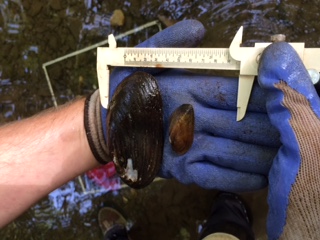Click here for the official Accotink Creek Mussel Survey
From September 22 through September 24, 2015, biologists of Daguna Consulting conducted a professional survey of the freshwater mussel populations in Accotink Creek, guided and assisted by volunteers.

The Friends of Accotink Creek have for years pondered the status of freshwater mussels in our creek. We found living mussels and shells only in the one-mile stretch of the creek below the dam and even there, juveniles were scarce. When funds permitted, aided by the support of Friends of Lake Accotink Park, we contracted with Daguna to solve the mussel mysteries:
- Why are mussels found only below the dam?
- Is the population viable?
- Is the population reproducing?
Using above-water observations, bathyscopes, and snorkeling in a visual survey, combined with random grid exploration of the
streambed, the surveyors found these preliminary answers:
- The mussel poulation below the dam is about 10,000 individuals.
- Most of these are the Eastern eliptio (Eliptio complanata.
- About 10% are the Paper pondshell (Utterbakia imbecillis).
- There are also scattered numbers of the Eastern floater (Pyganodon cataracta).
- The presence of juveniles estimated at two years of age indicates reproduction is occuring.
- Only one single individual was found elswhere in Accotink Creek, in Eakin Park.
- Causes of absence of mussels in other parts of the creek likely include increased dissolved oxygen below the dam, algae and plankton from the lake providing increased food, and the higher population of American eels (Anguilla rostrata) which provide mobility to Eastern elliptio larvae.
- The single greatest factor, however appears to be the dam's role in capturing sediment. Elsewhere along the creek, shifting fine sediments like sand and silt probably bury mussels and cause mortality in excess of reproduction rates.
A sharp-eyed examination of the streambed just below the dam shows the difference - most of the bottom is covered with gravel and stones. Elsewhere along Accotink Creek, sand bars are more common and larger; when they frequently shift during rainstorms, mussels may be buried too deeply to extract themselves. These large quantities of fine sediment are not natural. Stormwater rushing off roofs and paved surfaces, directed down stormdrains into the creek, scours the banks and cuts away the bottom of the stream. Much more of the rain falling on wooded areas is able to soak in, recharging aquifers that keep our streams flowing year-round.
We were pleased that the enthusiastic biologists of Daguna surveyed several representative sections of Accotink Creek beyond the stretch below the dam we had originally proposed. Sections of about 300 meters each that were surveyed were:
- Lake Accotink Park from below the confluence with Long Branch to Braddock Road
- Eakin Park downstream from Prosperity Avenue
- Thaiss Park downstream from Pickett Road
- Accotink Stream Valley Park downstream from Fullerton Road
- Accotink stream Valley Park upstream from Telegraph Road
We were also pleased to learn the viable mussel habitat below the dam extends farther downstream than we had realized, as far as the second Cross County Trail bridge from the dam.
We were surprised to locate three American eels below the dam during the survey. American eels are the hosts species for Eastern elliptio larvae.
Unfortunately, the survey did not include Lake Accotink itself. Perhaps another time. If anyone has observations of mussels or mussel shells found in the lake, please do share them.
Interesting freshwater mussel facts:
- Paper pondshells are native in the Mississippi/Ohio basin. They are now common on the Atlantic side of the Appalachians, having likely arrived as larvae attached to stocked fish.
- Although very young juveniles may attach themselves to one spot, as adult marine mussels do, adult freshwater mussels are
free-living and capable of mobility.
- Thin-shelled freshwater mussels, such as the Paper pondshell and Eastern floater can move by respiring a bubble of gas inside their closed shell, thereby gaining buoyancy and drifting with the current.
- Freshwater mussels can also move by extending their "foot" from the shell and dragging themselves along. Their tracks are sometimes visible in shallow water.
- Freshwater mussels send their larvae out into the world by temporarily attaching them to the gills of fish, often specializing in just one species of fish. Some mussel species have elaborate lures to attract fish for this purpose.
- Accotink Creek's most common mussel, the Eastern elliptio, prefers to transport its larvae on the American eel, whose upstream migration is discouraged by the dam..
- North America is home to the worlds greatest diversity of freshwater mussels, with over 300 species, concentrated in southwest Virginia and neighboring areas.
- Mussels are filter feeders, each one filtering and purifying several gallons of water daily.
Friends of Accotink Creek and Friends of Lake Accotink Park conduct rescues of freshwater mussels. Anytime the USGS stream gauge spikes above 2000 cubic feet per second, mussels will be washed out of the channel and stranded. Look for them on gravel bars or in shallow puddles and return them to deeper water before the raccoons find them.

Searching for mussels with bathyscopes and snorkeling.
"The Mussel's Creed"
If when I stand before the seat of final judgment I can say:
- I accepted life without complaint,
- I harmed no fellow living thing,
- I lived each day in service to all around me,
- And perhaps once in a great while, I brought forth a pearl,
...I will be almost as worthy to enter as these lowly river mussels.
Let us not let these fellow creatures be sent to that judgment before their times.
- Care about Accotink Creek.

|




